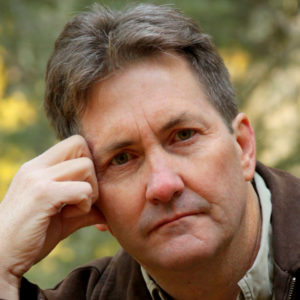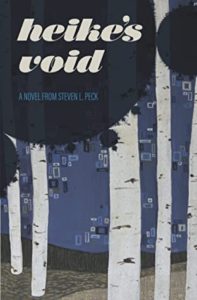Spoiler alert (although by this time, a year after publication, it probably doesn’t matter).
I was thinking, “I need to do a review of Heike’s Void.” Interest is slowing, and I thought another review was in order—so why not write one myself! There have been several wonderful reviews and blurbs but what I’m doing theologically likely needs some elaboration. Warning—I may be biased.
I’ve just been listening to a book about the philosopher Soren Kierkegaard, the Danish philosopher that pondered existence more deeply than anyone I know. He was full of contradictions and often wrote under a pseudonym. In one of his last works, The Point of View of My Work as an Author, he spills the dirt on what he was trying to do. I decided to take a page from him (he is a bit of a hero to me) and explain some things I was thinking about when I wrote Heike’s Void.
I’m sitting in my backyard watching a monarch flit around a small patch of milkweed that lives in our backyard. About fifteen years ago, I found a milkweed plant growing by itself along the Murdock Canal near my home. (It has since been moved under a great pipe and paved to provide a walking and biking trail). The butterfly has been hovering all afternoon near the foliage, not moving more than 30 yards away before it returns to this unique foliage and samples nectar from its abundant flowers. Monarchs lay their eggs on milkweed, which secondary chemicals make the lepidopteran taste bird-defying nasty to predators. I knew this when I brought this large-leafed volunteer back to my backyard and carefully planted it–translating it from weed to ornamental.
 There is now a cluster of about eight stems amply festooned with oversized leaves and flourishing flowers. This is the first monarch I’ve seen in 15 years of the plant’s existence in my backyard. How did it find this lone patch in the vast array of suburban backyards where this variety is rare (and viewed as a noxious herb)? A combination of accident, the seepage of plant-specific smells to which the butterfly was drawn, and a host of other contingent factors have allowed this orange and black insect to appear in my garden. It’s been a few hours, and the monarch is still flitting around the plant, the center of its oval of repeated visits and interests. It wants to stay near its future larvae’s host-home, or it is repeatedly assessing the wider ecological milieu in which its offspring will have to survive. How wonderful the combination of random chance, evolutionary history, and my desire to attract this species have conspired to let me enjoy a warm spring day watching the fruits of a 15-year-old wish be fulfilled. So much randomness and contingency in the world. Everything around me bears witness that our universe is chock-full of unpredictability, novelty, and variance at every scale. In fact, the variety of possible ways of being depends on randomness being in full force in its play through the universe. This is not to say that there are no structures, but all life on Earth has evolved in the presence of randomness and must take unpredictability into account in its functioning on this planet.
There is now a cluster of about eight stems amply festooned with oversized leaves and flourishing flowers. This is the first monarch I’ve seen in 15 years of the plant’s existence in my backyard. How did it find this lone patch in the vast array of suburban backyards where this variety is rare (and viewed as a noxious herb)? A combination of accident, the seepage of plant-specific smells to which the butterfly was drawn, and a host of other contingent factors have allowed this orange and black insect to appear in my garden. It’s been a few hours, and the monarch is still flitting around the plant, the center of its oval of repeated visits and interests. It wants to stay near its future larvae’s host-home, or it is repeatedly assessing the wider ecological milieu in which its offspring will have to survive. How wonderful the combination of random chance, evolutionary history, and my desire to attract this species have conspired to let me enjoy a warm spring day watching the fruits of a 15-year-old wish be fulfilled. So much randomness and contingency in the world. Everything around me bears witness that our universe is chock-full of unpredictability, novelty, and variance at every scale. In fact, the variety of possible ways of being depends on randomness being in full force in its play through the universe. This is not to say that there are no structures, but all life on Earth has evolved in the presence of randomness and must take unpredictability into account in its functioning on this planet.
This sets the stage for my exploration of Heike’s Void. Complexity theorist, Stuart Kauffman, writes in much of his work about the adjacent possible. He means a new universe is just a random flit away from our current universe’s temporal place in the cosmos. Not in the sense of a “multiverse” so popular today in the Marvel Universe. No, what he means by the term is that a new universe with a richer potential novelty, opportunity, life and being emerges into the future of this universe.
Both Einstein and Augustine conceived the cosmos as being complete, perfect. A fixed block of stuff in motion that runs according to irrevocable deterministic laws; just as the past looks to us as fixed, they saw the future just as set in a crystal lattice. All that was, and is, and will be, have, from God’s perspective (or any fixed observer), happened because there is not a modicum of change possible–for the Lord omnipotent sees the whole shebang end from the beginning. Not in terms of possibilities or aims, but just a bigger view of what is. What exists? It’s a strange static world in which there is no such thing as hope, change, or newness. An endless rerun of the same-ol’ same-ol’ playing out just as the equations and laws say they ought. Eighteenth Century French mathematician Pierre-Simon Laplace’s imagined demon who, knowing the momentum and position of every particle in the universe, could calculate all fates past or future. Randomness foreclosed. Worlds without end. Finite ones, mind you, for sadly, if you buy into Einstein’s or Augustinian’s block universe with its forever-fixed number of possible elements and positions, the number of possible worlds is finite. It will, of course, in the end, end. I long for richer eternities. This crapfest of Platonic thought that crept into the main branches of monotheistic theology through Neoplatonic thought has no place in the restoration. Or so I argue.
So, in this review of my work Heike’s Void, I want to explore some of the contradictions I use to destroy some fixtures (or perhaps, “temptations” is more descriptive?) of Neoplatonic thought. I subvert theology in the opening line, “There are those God hates.” If love is just a feature of God’s being, then love is not a virtue, not a reason for making deities worship-worthy. It’s just something that appears from nothing, thereby an arbitrary and contingent fact of their existence. Therefore, any god who just “is love,” rather than has chosen love, is just a fact of existence. It doesn’t mean anything.
The second subversion of Neoplatonism is the void empty of the Null set, which does not exist because by definition every set has the null, but what if it doesn’t? Another perversion is because it means there is no access inside the void; set elements cannot be added. Throughout the book, absolutes as transcendental objects are twisted out of meaning what they usually should mean. This is what all the epigraphs are about.
There are many such binary opposites. An eco-theology student who becomes immersed in revenge. How mistakes partake of the contingent but open new worlds of opportunity. Nature/neuter – what are we if we are slaves to our neurology? Does Heike become more or less than Regina? Which is the ‘real’ person? The neurological diminished person, who seems more capable and complete as a person than the person narrowed by hate and revenge? What of Alma Lune? Why is he devoted to his lover’s father at the expense of an expression of his authentic self? What is lost or gained in that sacrifice? Is it a way to honor his deceased husband? Is it a betrayal of that relationship, or does it honor it? Can it not do both? What of Holmberg? He professes God’s love at every turn and yet allows that love to be masked by his fear of homosexuality. How does his son’s death from AIDS affect his ability to love others when he does not allow certain others to live equitably in the world for poorly articulated or fabulated doctrinal reasons?
In the book, only immanence matters. There is nothing of the absolute floating above the world. No Augustinian/Einsteinian block universe floating in a big-U universe based on the fine-grained determinism of God’s omniscience. In everything, the book is about matter. Its ineffability as a divine and mundane force. Angels live in an existence replete with uncertainty and doubt. Taking literally the claim in D&C 130: 2, “… that same sociality which exists among us here will exist among us there.” Wounds that appear in the flesh, like Sam’s congenitally malformed feet, remain post-resurrection as he hobbles through the eternities, subverting and reimagining what a perfect body means. What determines “perfection” is undermined thereby. In a world without Platonic forms, there is no perfect to which we can aim in our attempts at mapping out our existence–Only novelty matters, and only matter allows us to move in a world in which ideal forms are plastic.
In the end, as Heike and Regina reintegrate into a new being, the categories into which each have been walled are destroyed. Again and again, in the novel, binaries are wrecked: theology, mathematics, perfection, ideals that float above the muddy matter that are thought to somehow impose their sovereign will on matter, nature vs. nurture, health vs. disability. Ultimately, the atonement works not as a correction for brokenness but as a navigational tool in a world where chaos reigns. Where God’s choice to love serves as a backdrop for protecting and embracing novelty– the only to push forward into the full possibilities of existence. God’s grace is God’s decision to choose love in a universe where we make meaning through agency, opening the vast possibilities afforded thereby. Stuart Kauffman’s adjacent possible.
This is the real reason Satan’s plan would fail, as articulated by Mormon folk theology. Satan’s plan was based upon a universe of lock-step determinism. No free-wheeling part. A universe in which reductionism works and laws stand as sentinels guarding against new potentialities, new capabilities, and new ways of letting love enter the fabric of time, space, and being. Satan would ensure a world in which everyone could be saved–one just had to embrace the machine as the model for humanity. He was rejected because choosing love requires freedom (what is love without freedom?), it requires risk, uncertainty, and doubtful ends worth pursuing even if they don’t turn out. Here on Earth, we spend an enormous amount of time learning to master faith, hope, and charity, all features that are part of the universe in that God and we find ourselves. Not the one Satan wanted to engineer through intelligent design into the great flat algorithmic AI in the sky.
This is just one view of Heike’s Void. But you should read the book’s other reviews and blurbs. The book was nominated for both the AML novel award and the Whitney Award in 2022.
 Steven L. Peck is an Utah native from Moab, Utah, and currently lives in Pleasant Grove. He is an ecology professor at Brigham Young University, and the author of novels, short fiction, and poetry, which explore relationships with science, religion, evolution, consciousness, and the ways humans interact with the other inhabitants of this planet. He is a two-time winner of the Association of Mormon Letters Novel Award (The Scholar of Moab, 2011, Gilda Trillim, 2017), and once for short story (Two-Dog Dose, 2014). He was awarded the 2021 Smith-Pettit Foundation Award for Outstanding Contribution to Mormon Letters.
Steven L. Peck is an Utah native from Moab, Utah, and currently lives in Pleasant Grove. He is an ecology professor at Brigham Young University, and the author of novels, short fiction, and poetry, which explore relationships with science, religion, evolution, consciousness, and the ways humans interact with the other inhabitants of this planet. He is a two-time winner of the Association of Mormon Letters Novel Award (The Scholar of Moab, 2011, Gilda Trillim, 2017), and once for short story (Two-Dog Dose, 2014). He was awarded the 2021 Smith-Pettit Foundation Award for Outstanding Contribution to Mormon Letters.


I really enjoy reading deep thoughts by William Morris (on the categorization of recent Mormon fiction) and Steven Peck (about the ideas that inspired and anti-inspired him in writing Heike’s Void). Let me just add that both of them also write great stories, with vibrant, complicated characters. It is delightful to immerse myself in books that weave interesting ideas into captivating stories.
.
I love it. And I love that Kennedy poem.